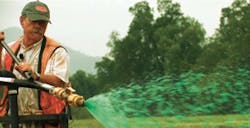John McCullah started working with dirt as a landscape contractor after having earned degrees in botany, geology, and forest and range hydrology from Santa Cruz Cabrillo College and Humboldt State University in California. Today, he calls himself a fluvial geomorphologist…and much more.
McCullah owns Salix Applied Earthcare in Redding, CA, a company that designs, develops, reviews, and implements erosion control plans. He offers best management practices workshops. He develops guidance manuals. He developed the award-winning Erosion Draw, a BMP manual of industry standards and new technology to reduce erosion and sedimentation on construction sites and comply with National Pollutant Discharge Elimination System requirements. He also developed Bio Draw, a CD-ROM compilation of biotechnical erosion control techniques with CAD drawings.
He served on the International Erosion Control Association’s national board for five years and has been a member of the organization for 21. He’s been an IECA keynote speaker in New Zealand and Australia. Remembering the excitement he felt when attending his first IECA conference in the early 1990s, McCullah says, “I found a fellowship of like-minded individuals. I’ve been hooked ever since.”
What Attracted Him to Erosion and Sediment Control
During a visit to a hardware store while he was a landscape contractor, McCullah noticed a display proclaiming October as “erosion control month” and suggesting interested parties contact the local soil district for more information. He did just that and within a year (1988) became a Certified Professional in Erosion and Sediment Control, writing erosion and sediment control reports. “It was a field that brought everything together in natural resources,” he notes. “I loved it immediately.”
How He Spends His Days
McCullah works seven days a week, although he says he’s slowing down and picking the “choice” jobs, which he describes as the ones with the most challenges. McCullah builds projects: designing, acquiring permits, leasing equipment, and constructing them. He’s worked in stream restoration globally, including New Zealand and Alberta, Canada. He spends most of his time as an educator, training and assimilating information on erosion and sediment control, watershed restoration, and stream stabilization. McCullah has compiled more than two-dozen episodes of “Dirt Time,” a video series addressing a variety of erosion and sediment control techniques.
He notes an increased need for required training for regulators. “Contractors are required to have a certain level of training before they can even bid on a job. We require installers and stormwater pollution prevention plan developers to have training and certification,” he points out. “There needs to be the same training level for regulators. Unfortunately, it has become an inconsistent playing field. Regulators understand regs, but don’t have the basic soil erosion or sediment control understanding of the physical processes. They also need continuing education.”
What He Likes Best About His Work
“Every day is different,” says McCullah. “There is no prescription for how things are going to work. There are always new challenges of awareness in education-why people should care and all of the technical aspects. My good friend David L. Derrick [stream restorer, IECA member, and teacher] and I say this isn’t brain surgery-it’s more difficult.”
His Toughest Challenge
McCullah’s biggest challenge came one time in obtaining permits for a local restoration project via his nonprofit, public-benefit corporation, Sacramento Watersheds Action Group. “It was outrageous to do mitigation on a stream damaged by 100-year-old mining as though we were building a golf course or subdivision, when we were already mitigating for wrongs of the past,” McCullah says, adding that it’s a challenge faced by restoration groups nationwide. “You have every environmental regulation in the book thrown at you when mitigation is in a different category altogether. These are peer-reviewed restoration projects that receive funding from an agency or panel that looks at all of the nation’s worst problems. For a local or federal entity to cost the group one-third of that money to get environmental documentation is obscene and difficult. The nonprofit went bankrupt. It makes people like myself want to give up.” The project eventually went forward, though, and McCullah returned to the site the first winter after the restoration of the stream to its ancient channel. What he saw left him awestruck: 30 pairs of salmon spawning, a bald eagle, and hawks. At that moment, McCullah says, “I felt like it was all worth it.”


